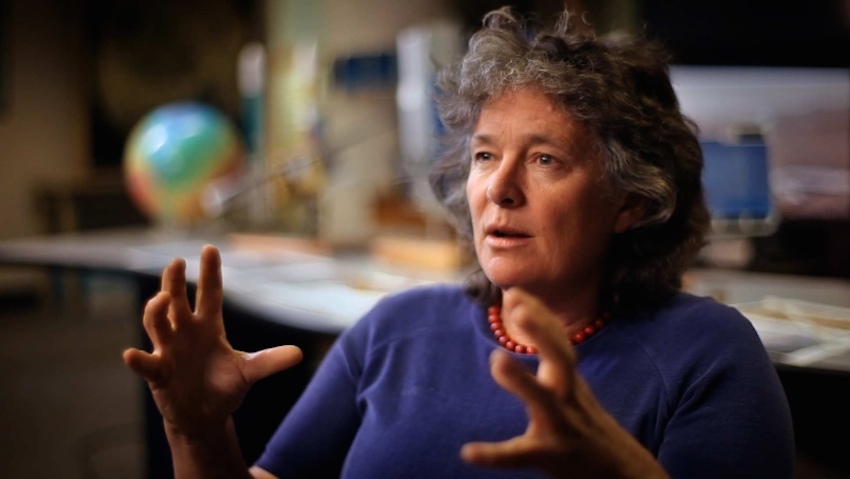
Fran Bagenal
Co-Investigator for the New Horizons Mission - Boulder
This profile has been adapted from an original interview conducted by Kelsi Singer for the Woman in Planetary Science website. To read the full interview click here.
I am originally from Dorchester, England, but I grew up in the flatlands near Cambridge, England.
I was an Apollo kid. When I was a teenager in rural England I stayed up through the middle of the night to watch the Apollo astronauts walk on the Moon. Also, every week I watched BBC's "Horizons" documentaries, which showed current scientific topics -- I was most interested in plate tectonics and space exploration.
I studied physics/geophysics at Lancaster University. I was thinking about a career as an exploration geophysicist, but keeping an eye on the U.S. space program. I did not know what to do for graduate studies, so I put off the decision by applying to spend a year studying in the U.S. I ended up taking a summer job at the Massachusetts Institute of Technology (MIT). At that time, the two Voyager spacecraft, Voyager 1 and Voyager 2, were just being launched, and I worked with the Voyager Plasma Science team. So, the choice was obvious to stay and work on data from Voyager at Jupiter.
Amusingly, I got my first job offer via a conversation in a woman's room. In 1981, at a Magnetospheres of the Outer Planets meeting, my thesis work was being shown by several speakers and during a break, a female senior scientist asked me what I planned to do next. I replied that I was thinking of going back to England. She went back to the meeting and at the next break a British scientist she was sitting next to offered me a job. After a year finishing up work at MIT (and a trip to climb mountains in Peru) I started a post-doc at Imperial College (IC) in London. I spent five years at IC -- getting a fellowship to support later years.
Due to decreased academic research funding and little planetary research in the U.K. it became clear to me that I wanted to return to the U.S. I also realized I felt more comfortable in the American academic system. Soon after this, I got an email from my Voyager colleagues in Boulder saying that the University of Colorado (CU) was looking for faculty in the physical sciences. As a climber and a skier, I realized that Boulder was clearly the place I wanted to live. I was given tenure four years later and have been on the faculty at CU for 21 years.
Carl Sagan. My older brother was studying at Cambridge University and he invited me to a talk that was being given by Sagan. At this talk, Sagan spoke about the Mariner 9 exploration of Mars, and he showed us images (fuzzy compared with those taken recently). What impressed me was the way he addressed the questioning from the (rather stuffy) Cambridge academics with honest discussion of the science and intellectual challenges.
I am a professor of astrophysical and planetary sciences at the University of Colorado, Boulder. My favorite classes to teach are the smaller classes for majors in planetary science where students keep asking great questions and we discuss the latest data coming in from a planetary mission.
I am also a co-investigator on the New Horizons mission. I really enjoy my involvement in space missions -- it is the best part of my job -- Voyager, Galileo, Deep Space 1, New Horizons, and Juno. Usually, I am on the science team as a plasma scientist. I study the magnetic fields of planets, the ionized gases trapped in those magnetic fields and the interactions of plasma with the atmospheres of moons, comets, etc. You can study such phenomena by either using instruments on spacecraft that fly through the plasma or via their emissions at different wavelengths -- ideally, using both techniques together.
The rewards are, without question, seeing the new data coming in. During the 1979 Voyager 1 flyby of Jupiter, I remember seeing the data coming out of a printer which showed the measurements of ionized sulfur and oxygen from the recently discovered volcanoes on Io.
The challenges of mission work are the effort and time it takes to get there -- advocating the mission, proposing, designing, building, launching, getting out to the planet and then, finally, waiting for the data to come back. For Jupiter missions, the process takes about 10-15 years. We started working on a mission to Pluto in 1989 -- 26 years before New Horizons is due to fly past Pluto.
It's a great job! And there are all sorts of jobs—mission design, mission operations, data analysis, modeling. You need to think about what you like doing most. Is it digging through the data to find the nugget you know is there? Is it developing a model and seeing the science evolving in progressively complex plots? Is it discussing with a team how to implement a set of measurements? Yes, grades are important. Yes, publications are important. But also, contrary to common misconception, getting along with people is also important—perhaps as important as solving big equations.
I am a rock climber and I enjoy skiing.
Talk with a range of people about what it takes to succeed in different types of jobs. Also, learn the basic tools (math, writing, programming, presenting—and arguing!)—you can apply them to multiple situations.
Planetary science is a global profession.

